Thorny spruce "Glauka": description, varieties and cultivation
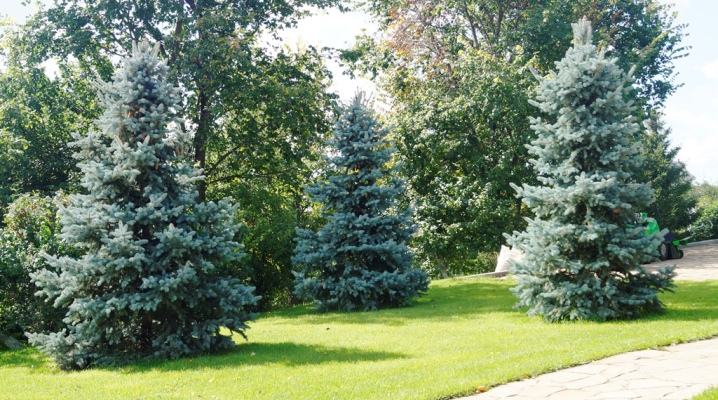
Blue spruces are associated with solemnity, so it is customary to plant them near great monuments, administrative buildings, and other city attractions. From the central squares, these beautiful trees are gradually "moving" to garden and summer cottages and become a decoration of a private courtyard. In order for the blue spruce to develop well and look solemn, it is important to know all the features of its cultivation.
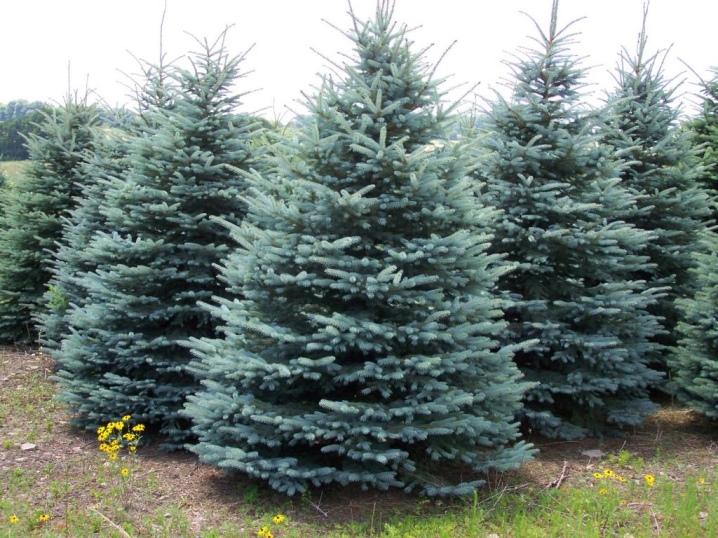
Description
Most blue spruce trees belong to one large group of varieties called Glauca. It is a wild species, more common in North America and surrounding regions. Prefers to live in highlands, in coastal areas, soils enriched with moisture. Usually, the trees of the Glauka group reach 25 m in height. They have a cone-shaped crown, the trunk is painted brown-gray, the structure of the bark is endowed with grooves and seals.
The main feature of the tree is its blue oblong hard needles, for which this spruce is called blue. The fruits of the plant are brown oval cones up to 10 cm in size. For the first 10-15 years, the tree has a taproot system, then the roots become superficial. Each year the tree grows 30 cm in height, and the width adds 10-15 cm per year. Flowering usually occurs in May-June.
With proper maintenance, blue spruce can live up to 300 years. This tree is not afraid of frosts, but it cannot boast of strong immunity to diseases and pests.
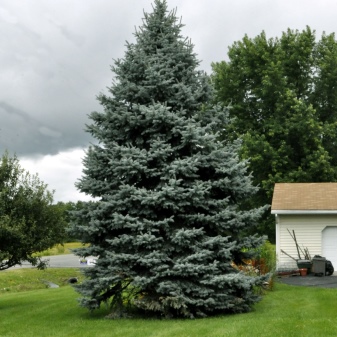
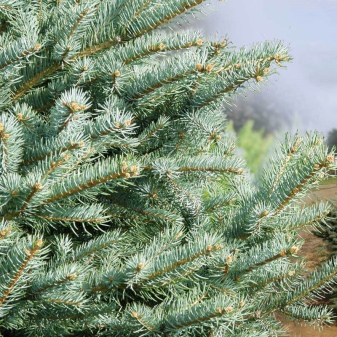
Varieties
As already mentioned, Glauka is a whole group of varieties, among which the most popular are the types described below.
- Glauka Globoza. It belongs to the genus of the pine family. The standard and dwarf varieties are distinguished. The most common classic version grows up to 30 m, adding 25-35 cm per year. Its needles are decorated with a wax bloom, which gives the spruce a very interesting appearance. The dwarf species does not even reach one meter in height, since it puts more energy into the growth of branches in width.
Gardeners appreciate Globoza for its unpretentiousness to growing conditions. For example, this tree becomes a frequent "inhabitant" of sites located in the northern regions of Russia.

- Glauka Konika. This variety is also called Canadian spruce. This is another dwarf species, not exceeding 4 m in height. It has soft needles and prefers to live in shady areas. The species is frost-resistant, but in the first years of life, it is customary to shelter a young tree for wintering. Spruce belongs to miniature varieties, but keeping is possible only on the street.
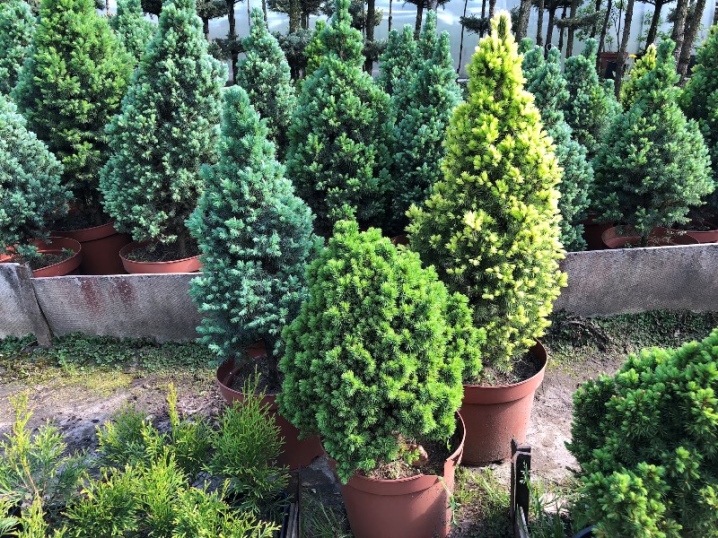
- Glauka Pendula. Differs in a weeping drooping crown. This species is obtained by the method of somatic mutation and reproduces only by grafting. Instead of a trunk, this tree has a massive branch that is tied to a support. The gardener controls the height by stopping the tying or, conversely, building up the support. In small areas, it is customary to grow this tree up to 3-5 m, wider areas allow you to form a spruce to a height of 8-10 m. It is imperative to tie this tree up, otherwise it will become similar to a thorny groundcover.
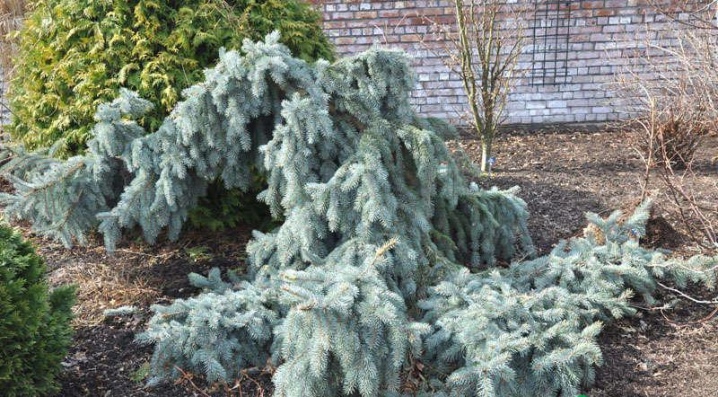
- Glauka Arizona. This variety can also be offered under the name Glauka Kaibab. The spruce reaches a height of 1.5-2 m. Its feature is densely located branches. In diameter, the crown develops up to 2-3 m.The needles have a silvery-blue tint, they are prickly, thick, up to 12 mm in length. In a shaded area, the needles can lose their blue color and acquire a dark green tint. The variety tolerates drought well, loves light, and is not picky about the soil.
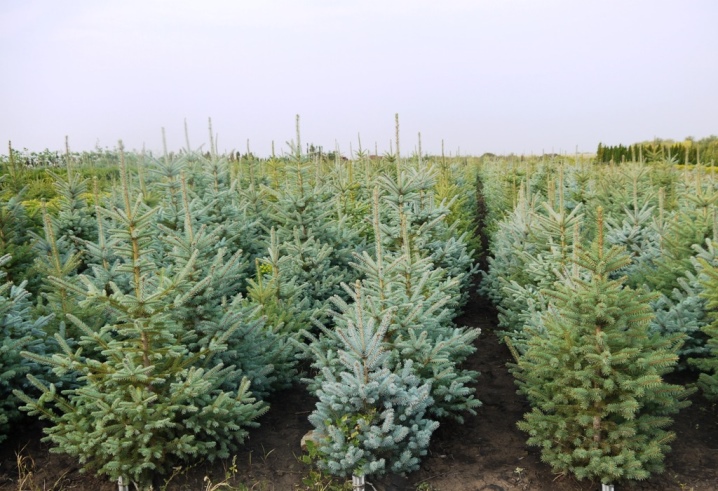
- Glauka Misty Blue. It is believed that this Glauka is of aristocratic origin. It is grown in elite European nurseries. Each seedling undergoes a rigorous selection here in order to get a shoot with high consumer qualities and ideal forms. The height of an adult tree reaches 30 m, the diameter of the crown is 4-5 m. The branches are dense, stable, and 3-centimeter needles differ in the same hardness. There is a wax coating on the needles, it is especially pronounced in the dry months. In the spring, you may notice pinkish bumps that gradually turn brown in color.
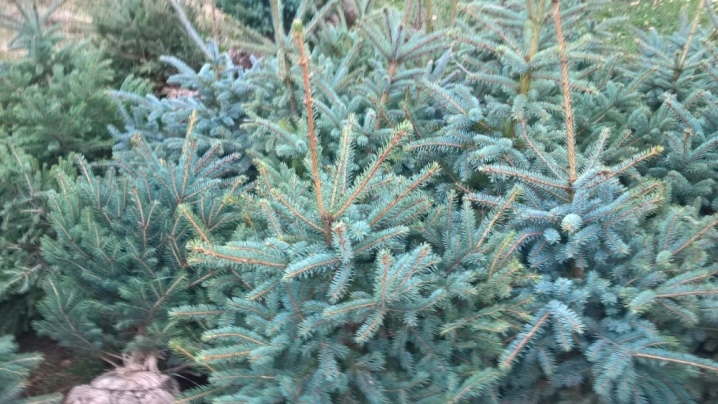
- Glauka Prokumbens. This tree is recommended for rockeries and container growing. The variety is also suitable for decorating roofs, terraces, balconies. It is characterized by its small size and flat-spread crown with branches lying on top of each other. The needles are dense, tough, dense, green in color.
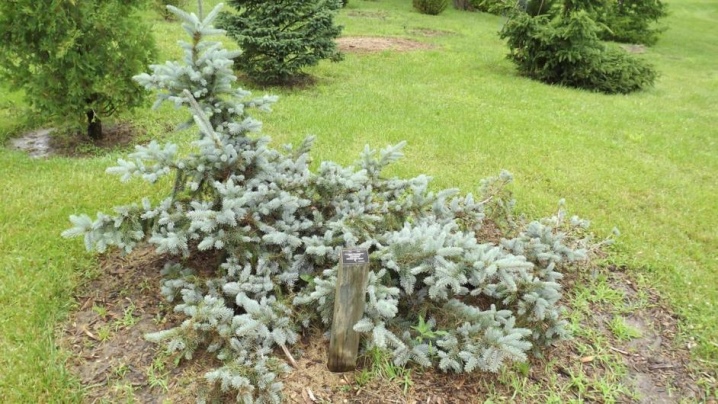
Landing rules
It is important to choose the most suitable area for the blue spruce before planting. This tree gives more preference to shady places, but it is not necessary to hide the culture completely from the sun. It must be ensured that it is not exposed to direct sunlight. Light and loamy soil is suitable as a soil. It is imperative to provide for a drainage system, since Glauka does not withstand stagnant water well.
It is also worth abandoning planting near groundwater. The best time to plant Glauka is mid-spring. Over the remaining months, young specimens will have time to get stronger and get used to new conditions before the onset of frost.
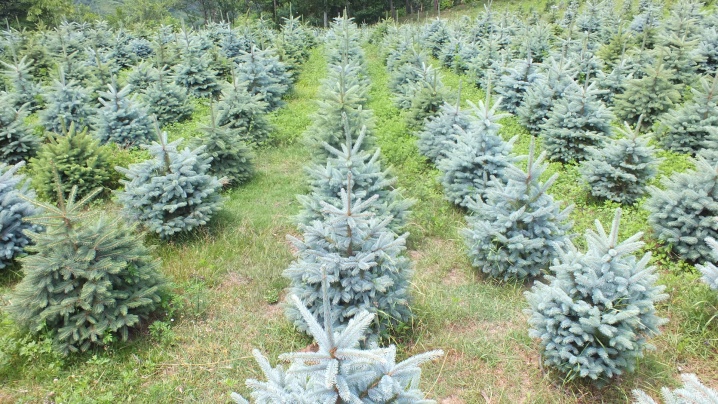
Another important criterion before planting is the choice of a seedling. A high-quality healthy shoot adapts to a new place faster, and also better tolerates harsh climatic conditions. It is necessary to choose planting material with a branched moist rhizome of a light color.
You should visually examine the crown - you should not take a tree with a lifeless drooping crown and yellowish needles. The surface of the seedling should be firm and bright. It is better to give preference to small-sized samples, since they adapt better to unusual conditions.
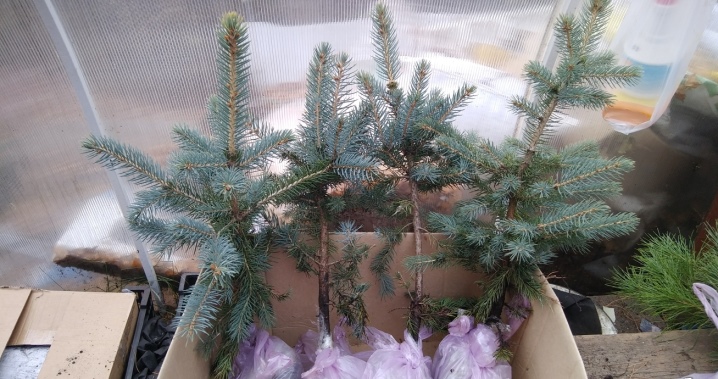
The planting process itself looks as described below.
- First of all, you need to dig a hole 60-70 cm deep and 50-60 cm wide. Install drainage - it can be organized from ceramic shards or small pebbles. The recommended drainage layer is at least 15 cm.
- The next layer is soil, combined with humus and peat.
- Then you need to place the planting material in the hole and cover it with earth so that the root collar does not look out. Sand should be poured around the planting - spruce trees do not like solid soil around the trunk.
- It is necessary to compact the ground a little and water the plant with water (20 l). Then mulch the site with peat or spruce needles.
- The next day, you need to loosen the soil around the seedling to a depth of 5-6 cm.
If a group planting is planned, then it is necessary to place specimens at a distance of at least 2 m, otherwise adult trees will interfere with each other, which will negatively affect their health and appearance.
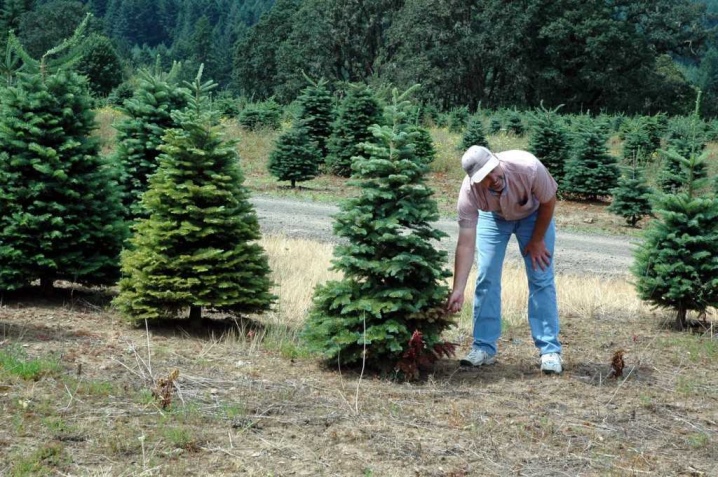
Care
Glauka should be looked after in the same way as other conifers. But there are some peculiarities in this process. Experienced growers give their recommendations for the care of blue spruce.
- The first two years after planting, it is necessary to supply the tree with water on time, and then loosen the soil around it. The culture should be watered in the evening once a week; each procedure will require 10 liters of water. Loosening after moistening is necessary for free access of the root system to oxygen.
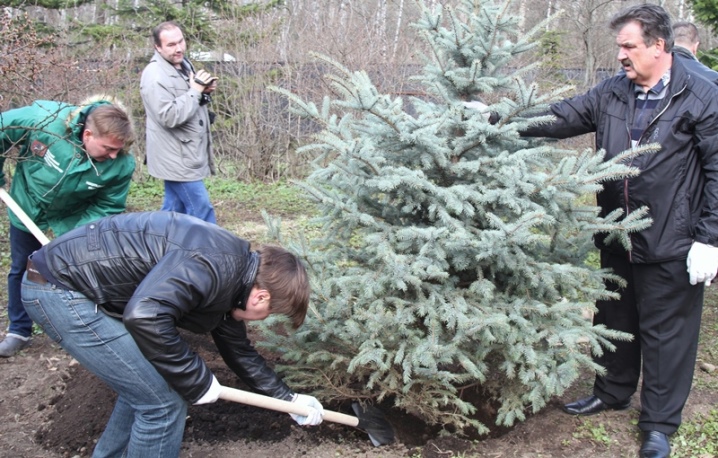
When loosening, you need to be careful - you do not need to injure young roots, because they are close to the surface. The more mature the spruce becomes, the less it needs loosening. The soil around the tree at the age of 6-7 years does not need to be loosened.
- Every year, young specimens need to be fertilized with mineral supplements. To protect the rhizome from frost, the soil around the trunk must be mulched - peat or sawdust is suitable for this. Adults ate no longer need insulation, as they fully develop on their own.
- Pruning when growing Glauka is not necessary unless it is a special variety like Pendula or the tree is planted as part of an artistic composition. In other cases, pruning is carried out only when dry or injured branches are formed; a sharp saw is used for the procedure.
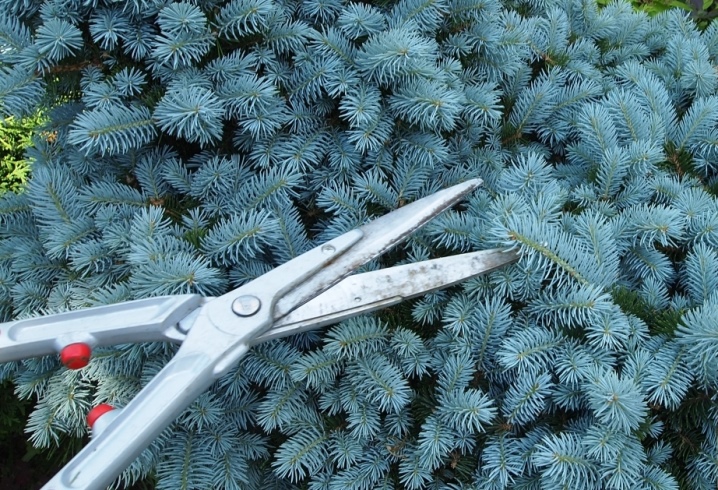
Diseases and pests
Spruce Glauka is a majestic tree that seems strong, sturdy, massive. However, this regal culture is quite vulnerable when the trunk is damaged by diseases and pests. Some parasites can kill the spruce. Most often, insects, presented below, like to feast on conifers.
- Stem pests. Their occurrence can be judged by the appearance of small depressions on the trunk. If pests attacked a young specimen, then they can destroy it, so they should be dealt with immediately. Gardeners usually use special insecticides to control insects.
- Spider mite. These individuals love to feast on dwarf crops. You can notice a tick by the presence of a thin layer of cobweb on the needles and yellow spots on the needles. To combat spider mites, complex acaricidal agents are used.
- Aphid. You can examine these small individuals under a magnifying glass. Their size does not exceed 2 mm. These creatures prefer to settle on the lower branches or on the bark of a coniferous tree. The most reliable remedy in the war against aphids is considered to be a soap solution, which should be used to treat areas damaged by insects.
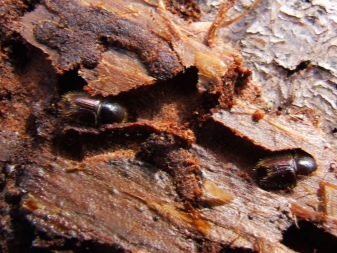
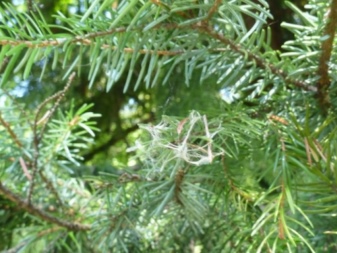
However, it is important to ensure that the soap does not get on the roots. Branches that have managed to be damaged by individuals are best eliminated and burned.
As for diseases, ate is most often affected by various types of fungus.
- Fungus Kabatina. The spruce, affected by this infection, begins to dry out from the upper shoots, gradually the tree completely withers under the influence of the disease. To combat fungus, gardeners prefer to use reusable systemic fungicide treatments.

- Rhizosphaera kalkhoffii fungus. The presence of this fungus is indicated by yellow needles, gradually acquiring a burgundy hue. They can also fly around. Most often, the disease affects the tree at the end of summer. Systemic fungicides are the most effective treatment for this fungus.
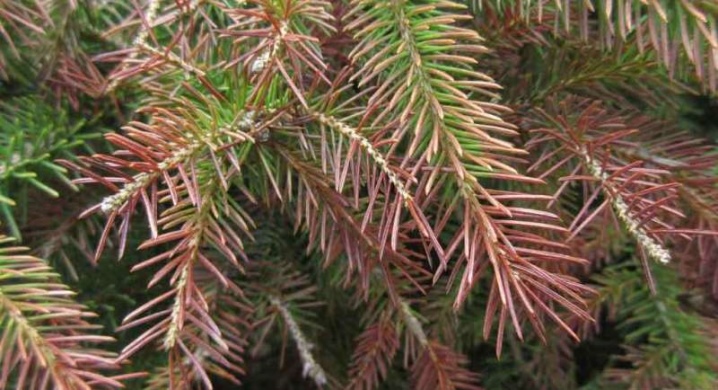
Use in landscape design
When creating a garden or suburban composition, many land owners prefer to use blue spruce. This is due to the interesting color of the tree and the original shape of the crown. Glauka is very beautifully combined with medium-sized trees, green shrubs. The tree looks aesthetically against the background of red, yellow and white flowers. Most often, the spruce is planted in the middle of the ensemble, although for some forms it is better to plant it in the back.
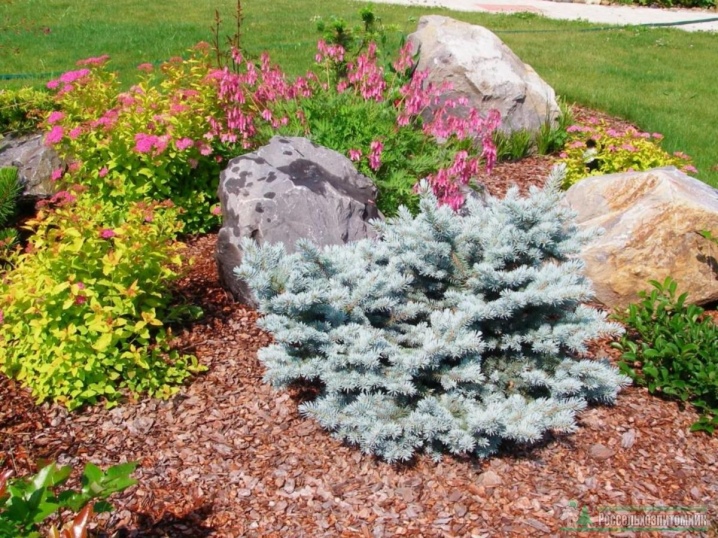
A single landing will look no worse. The luxurious blue crown will visually expand the site, and it will look equally beautiful at different times of the year. Glauka is often used to create a hedge, but in this case, additional efforts will be required from the gardener to care.
For example, he will often carry out crown pruning. However, this disadvantage is compensated for by the incredible composition formed from the combination of many trunks with bluish needles.
Blue spruce looks very harmonious in combination with other conifers. When decorating a plot, you can use combinations of thuja, juniper, yew, cypress, fir, larch, pine, cedar, boxwood, cryptomeria. Fences made of dwarf varieties of Glauka look unusual.

Also, miniature trees can be included in ready-made compositions. For example, Globoza is allowed to be planted along the garden path in the form of emerald balls. Some creative gardeners grow this variety in flowerpots, which is not only beautiful, but also practical, because portable flower beds can be interchanged, updating the appearance of the site.
For a description and care of the "Glauka" spruce, see the next video.



































































The comment was sent successfully.